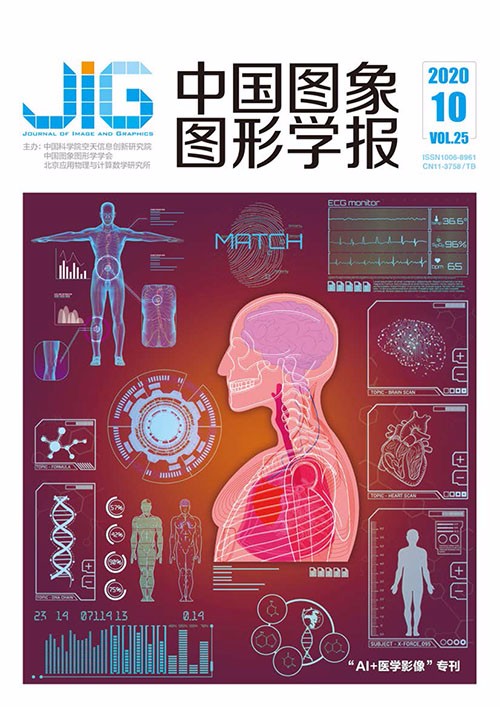
深度学习结合影像组学的肝脏肿瘤CT分割
摘 要
目的 从医学影像中进行肝脏与肿瘤分割是计算机辅助诊断和治疗的重要前提。常见的胸部和腹部扫描成像效果中,图像对比度偏低,边界模糊,需要医生丰富的临床解剖学知识才能准确地分割,所以精确的自动分割是一个极大的挑战。本文结合深度学习与医学影像组学,提出一种肝脏肿瘤CT(computed tomography)分割方法。方法 首先建立一个级联的2D图像端到端分割模型对肝脏和肿瘤同时进行分割,分割模型采用U-Net深度网络框架,在编码器与解码器内部模块以及编码器与解码器层次之间进行密集连接,这种多样化的特征融合可以获取更准确的全局位置特征和更丰富的局部细节纹理特征;同时融入子像素卷积与注意力机制,有利于分割出更加微小的肿瘤区域;接着生成两个用于后处理的学习模型,一个基于影像组学的分类模型用于假阳性肿瘤的去除;另一个基于3D体素块的分类模型用于分割边缘的细化。结果 实验数据来自某医院影像科300个肝癌病例CT,每个序列中的肝脏与肿瘤都是由10年以上的医学专家进行分割标注。对数据进行5倍交叉验证,敏感度(sensitivity)、命中率(positive predicted value)和戴斯系数(Dice coefficient)在验证结果中的平均值分别达到0.87±0.03、0.91±0.03和0.86±0.05,相比于性能第2的模型分别提高了0.03、0.02和0.04。结论 肝脏肿瘤CT的精确分割可以形成有价值的术前预判、术中监测和术后评价,有助于制定完善的手术治疗方案,提高肝脏肿瘤手术的成功率,且该方法不局限于肝脏肿瘤的分割,同样也适用于其他医学影像组织器官与肿瘤的分割。
关键词
Accurate segmentation method of liver tumor CT based on the combination of deep learning and radiomics
Liu Yunpeng1, Liu Guangpin1, Wang Renfang1, Jin Ran1, Sun Dechao1, Qiu Hong1, Dong Chen1, Li Jin1, Hong Guobin2(1.Zhejiang Wanli University, Ningbo 315000, China;2.The Fifth Hospital Affiliated to Zhongshan University, Zhongshan 528400, China) Abstract
Objective In clinical diagnosis, the manual segmentation of liver tumor needs to have anatomical knowledge and experience, which is highly subjective. Automatic segmentation of liver tumor based on computed tomography(CT) medical image research is important in guiding clinical diagnosis and treatment. It can form accurate preoperative prediction, intraoperative monitoring, and postoperative evaluation, which develop a perfect surgical treatment plan and improve the success rate of liver tumor surgery. However, a typical medical image is complex, which may contain many organs and tissues. In the imaging process, it often produces more or less interference information due to the influence of imaging equipment and human factors. According to the imaging principle and characteristics of medical imaging, not all information may be helpful for medical diagnosis. Whether CT or magnetic resonance imaging(MRI), as the common chest and abdomen scanning, in the imaging effect, the image contrast is low; the boundary is fuzzy; most of the time, accurate segmentation of interested organs and corresponding tumors requires clinical anatomy knowledge of doctors. In general, many boundaries are achieved through consultation between medical personnel. Notably, the automatic and accurate segmentation of liver tumor in medical images is a great challenge. In this paper, an effective segmentation method is proposed by combining multiple deep learning techniques with radiomics. Method First, a cascaded 2D image end-to-end segmentation model is established to segment the liver and tumor simultaneously. The segmentation model adopts the U-Net deep network framework, which connects the internal modules of the encoder and decoder and the layers of the encoder and decoder intensively. This diversified feature fusion can obtain accurate global position features and abundant local details or physical characteristics. Sub-pixel convolution is added during upsampling by pixel shuffling multiple low-resolution feature images to output the high-resolution image and make up for the loss of some image texture details. Given the small area and volume of the small tumor area, feature disappearance or weakening can easily occur in the convolutional neural network. A new attention gate model for medical imaging is used here to improve the segmentation performance of the tumor. This model can automatically learn the target with different volumes and shapes, which is suitable for liver tumor with the distribution characteristics of volume and shape polymorphism. Morphological expansion and corrosion may lead to the loss of some small areas, which are not continuous. Considering that CT scan is continuous in a short time, the lost areas can be recovered by using the continuity of this image in time. If there are segmentation regions in the former and latter image, but the current image does not, then the average value of the segmentation results before and after the current image is used. Given the heterogeneity of malignant tumors, the radiomic characteristics can be an effective, non-invasive imaging biomarker. In this paper, the radiomic features are divided into eight groups: histogram statistical features, gradient features, run-length texture features, gray-level co-occurrence matrix texture features, shape-based features, second-order moment features, boundary features, and three-dimensional wavelet features. According to a known research scope, considerable domestic and foreign research literature of radiomics show that the comprehensive performance of the random forest model is the best, and the random forest classifier is also selected to remove the false-positive tumor. Some segmentation areas are more accurate after morphological operation, but some segmentation areas will be larger than the real results. Therefore, the edge contour must be further refined. Here, the classification based on 3D image blocks does not need complex convolutional neural network(CNN), and simple CNN can achieve a good classification effect. The AlexNet model framework is selected and adjusted accordingly to refine the contour. Result The experimental data are from 300 cases of liver cancer in the imaging department of the cooperative hospital. The liver and tumor in each sequence are segmented and labeled by medical experts for more than 10 years. The average accuracy of sensitivity, positive predicted value, and Dice coefficient in the validation results are 0.87 ±0.03, 0.91 ±0.03, and 0.86 ±0.05, respectively, which are improved by 0.03, 0.02, and 0.04, respectively, compared with the model with the second performance. The training process of the method proposed in this paper is not end-to-end but is completed by three learning models, which are generally carried out on the GPU server under the Linux system. After the model training, the image can be arranged in the server or the general PC client. If the image is in the server, the image needs to request and transmit the sequence image through the network and then return to the client after segmentation. A typical way is to upload the image to the server and perform offline batch segmentation. After processing, only the segmentation result data will be returned. Conclusion In clinical diagnosis, the automatic or semi-automatic segmentation of the liver and tumor in CT medical image by using artificial intelligence and computer vision technology gradually replaces the pure artificial operation mode. The method proposed in this paper is not limited to the segmentation of liver tumors but also applicable to the segmentation of other medical imaging organs and tumors. In the future research, we will integrate the generative adversarial network technology to improve the segmentation performance.
Keywords
|



 中国图象图形学报 │ 京ICP备05080539号-4 │ 本系统由
中国图象图形学报 │ 京ICP备05080539号-4 │ 本系统由